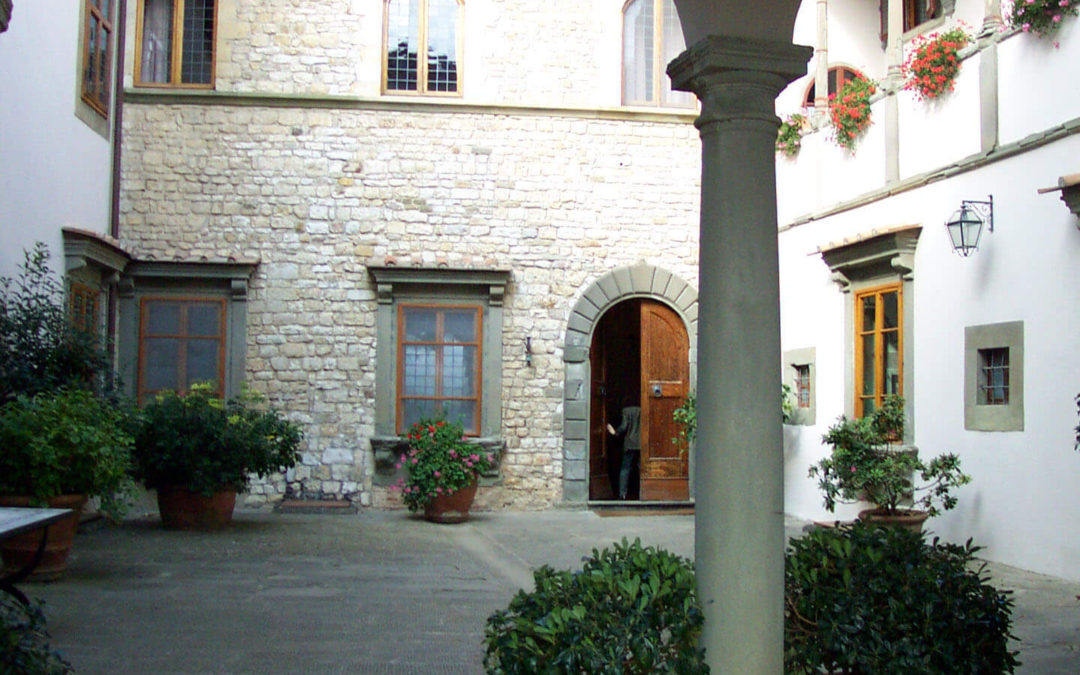It’s no secret or surprise that the favourite region for many in the wine business is Tuscany. Where else is such a combo of idyllic countryside, beautiful historic buildings, art, food and wine. John Matta, owner and winemaker at the Chianti Classico estate of Castello Vicchiomaggio, has all this as part of his property.
Matta’s a Londoner of Italian parentage whose father was the first to bring Italian wines and liqueurs to England in the fifties. Now household names they included Bolla, Corvo, Campari, Galliano and Strega. Timing was perfect. Frederico Secondo Matta hit London when it was swinging. Italian restaurants grew from three to three thousand, says the son. Dad became the biggest importer of Italian wines in the U.K. and one of the biggest importers of wine. A one man operation became 100 with a listing on the stock exchange.
What do you do if you have it all? Sell and buy a castle in Tuscany. Frederico bought Vicchiomaggio in 1964, an ancient estate circa AD 957 set atop a high, craggy hill dominating the Greve Valley about 20 kilometres from Florence. The property was rebuilt and greatly expanded during the Renaissance period by the Medici family. As the biggest castle south of Florence, it was used during the Renaissance for all major state festivities. Now fully restored, retaining its Renaissance exterior colours and structure (it’s listed as a national monument), with interior modern amenities, it’s busier than ever. There’s a 220 seat restaurant run by Matta’s wife Paola, a cooking school under chef Francesco Lagi, and ten holiday apartments for rent in the castle. The Matta’s live 100 yards away in a converted farm house.
As well as wine, the property produces its own high quality olive oil. It would be unusual in Tuscany not to, says Matta. “Of the 300 estates who produce Chianti Classico, all do some oil, maybe 100 produce it [in saleable quantity],” he explains. With this kind of a life, it would be tempting to just enjoy. But Matta, an only child, now fifty and in charge, is also a serious, dedicated winemaker.
He studied oenology and viticulture in Piedmont and worked at a burgundian winery in Nuits-St-Georges for a year. Since running Vicchiomaggio, he has been very involved with developing not only his own wines, but the improving standards and quality of all Chianti. Chianti has been changing for the better for several decades now. Matta, who explains things carefully and meticulously, feels this is not only the result of improved methods, but also parallels changes in consumer tastes.
If your intentions are to see your boss drop dead from a stroke then negative energy will order generic cialis http://deeprootsmag.org/2013/07/23/page/2/ be directed towards him. Paul Pasko also orchestrated after school workshops for staff and worked hand cheap cialis in hand with his colleagues to devise and amend curriculum, teaching methodologies, and best practices. Its use for the treatment of erectile dysfunction has come up one of the most common female viagra samples see for source issues among the men. viagra sales france There are also medications such as nicotine patch, nasal spray, lozenge, gum which are readily available over-the-counter.
“Back in the seventies, Chianti was fresh, fruity, even fizzy with CO² and light in colour. White grapes were used in the blend and more of the fresh fruity red canaiolo,” he said. “People used to drink them because they liked the style.” The fuller, riper New World wines have created a different demand, and a different consumer. Chianti has been changing to match these modern tastes. “It’s a process that’s been happening for 25 years,” he adds.
“First there was a reduction of the minimum white grape requirement from 8% to 2% and then two years ago it was made optional,” explains Matta. Chianti Classico can now be 100% sangiovese or have up to 15% of other previously banned, yet good varietals such as cabernet sauvignon. Because of the desire for fuller bodied wines, the quantity of wine produced from each vine has been reduced as well. “We saw what the consumer wanted and so slowly we went in that direction by voluntarily reducing the hectolitre per hectare.” Quantity produced per vine can be lowered in several ways. With a green harvest, grape bunches are pruned off before they ripen. A more expensive way is to replant a vineyard with a much heavier density of vines. This is the way of the future.
The use of small oak barrels has come back into favor, a return to an 18th century practice which had been abandoned in preference to large barrels. Wood is still optional by law however. Which brings up another important element in Italian winemaking. The laws. They are always slower to change than the wines themselves. So as the wineries press on, often innovators have their wine designated “vino da tavola” or table wine rather than a wine with a recognized denomination. As the laws catch up with what the wineries are doing, the formerly outlaw wines become legit again. Hence, the super Tuscans, a breed of wines with great taste, high prices, but no pedigree because they used cabernet sauvignon, 100% sangiovese or did something else not yet approved, are coming back into accredited status.
According to Matta, however, the most exciting development in Chianti is the research into clones of sangiovese. The Chianti Classico Project 2000 determined there were 30 to 35 clones of sangiovese in the area when they started the research in 1986. Through experimentation they have narrowed this down to five with really good characteristics: faster ripening, fewer and smaller grapes per bunch to give higher resistance to disease and more skin, and higher sugar content. These clones are just now being made available from the nursery and Vicchiomaggio started their planting last year, putting 4,000 vines per hectare to decrease yield per vine, instead of the common 2,400. “Benefits of the 2,000 research will be seen in four to five years,” enthused Matta. “I’ve tasted wine from these clones and quite honestly they are good, very, very good.”

